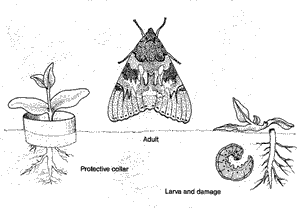 |
Cutworms commonly attack seedlings, severing their stems at or below the level of the soil. Active at night, they work quickly and invisibly. One day the young plants in an area of your yard are fine; the next day many of them (often up to 4 or 5 in a row) are leveled. Sometimes cutworms attack plant roots below the soil, causing them to wilt or collapse. They cut grass blades off at or near the soil surface, or eat tender grass roots, causing irregular brown dead patches in the turf which pull up easily because there are no longer roots to attach the sod to the soil.
Examine severed plants closely. If they look like they've been mowed, cutworms are probably responsible. However, if the stems are cut at an angle, rabbits may be the culprits. Sift the soil near the plants to find the worms, which curl into a ball if touched. In a bed of seedlings, one cutworm is too many. In a lawn, damage is evident when there are more than 5 cutworms per square foot. Vigorous grass plants growing in healthy soil that allow them to develop deep roots can tolerate more cutworms before damage becomes evident.
Plants Affected By Cutworm
Most common cutworm targets are:
Vegetable crops such as:
Beans, Broccoli, Cabbage, Lettuce,
Peas, Peppers, Tomatoes, Asparagus,
Carrots, Corn, Onions, Rhubarb.
Young fruit crops such as:
Blueberries, Grapes
Lawn Grasses such as:
Kentucky bluegrass, Perennial ryegrass,
Tall fescue, Bermuda grass, St. Augustine grass
Annual and perennial flower seedlings of all kinds.

